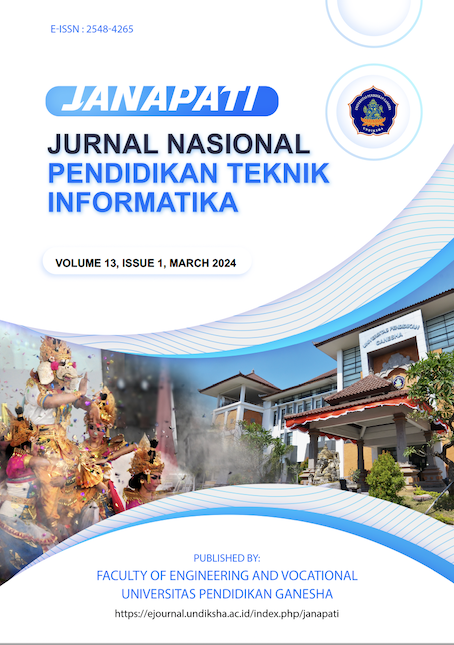Development of Augmented Reality Application as An Educational Media for Visitors to Museum Pusaka Keraton Kasepuhan Cirebon Using Object Tracking Method and Fast Corner Detection Algorithm Based on Android
DOI:
https://doi.org/10.23887/janapati.v13i1.68925Keywords:
Augmented Reality, Tracking Object, FAST Corner Detection, MuseumAbstract
Augmented Reality is a technology that combines two-dimensional or three-dimensional virtual objects and projects these virtual objects in real time. One implementation of Augmented Reality in the tourism sector is to educate museum visitors. Museum Pusaka Keraton Kasepuhan Cirebon does not yet have a touch of technology to attract visitors, and the public paradigm is that visiting the museum only sees heirloom objects, nothing interesting or unique. The aim of the research carried out by the author is to apply Augmented Reality with the Object Tracking method and the FAST Corner Detection algorithm to educate museum visitors, so that it can attract visitors' attention. By utilizing these methods and algorithms, it can be easier for visitors to explore heirloom objects to obtain the desired information. So the results obtained from the research conducted by the author are that the response time for objects appearing using the Tracking Object method and the FAST Corner Detection algorithm in environments that use glass is an average of 1.52 seconds to 2.40 seconds and that does not use glass, namely 2.84 seconds to 4.71 seconds with a level of confidence at the 95% level.
References
Maryati, W., & Masriani, I. (2019). Peluang bisnis di era digital bagi generasi muda dalam berwirausaha: strategi menguatkan perekonomian. Jurnal MEBIS (Manajemen Dan Bisnis), 4(2), 125-130.
Mohanty, P., Hassan, A., & Ekis, E. (2020). Augmented reality for relaunching tourism post-COVID-19: socially distant, virtually connected. Worldwide Hospitality and Tourism Themes, 12(6), 753-760.
Andika, Z. R., & Hidayat, D. (2021). Perancangan Aplikasi Untuk Museum Nasional Sejarah Alam Indonesia (munasain). eProceedings of Art & Design, 8(2).
Errichiello, L., Micera, R., Atzeni, M., & Del Chiappa, G. (2019). Exploring the implications of wearable virtual reality technology for museum visitors' experience: A cluster analysis. International Journal of Tourism Research, 21(5), 590-605.
Astari, W. Y., & Rochman, G. P. (2023). Hubungan Timbal Balik antar Aktor dalam Pengembangan Wisata Budaya Keraton Kota Cirebon. Jurnal Riset Perencanaan Wilayah dan Kota, 47-54.
Ningrum, K. I. (2020). Wisata religi dan pemberdayaan ekonomi pedagang di kawasan Keraton Kasepuhan kota Cirebon (Doctoral dissertation, IAIN Pekalongan).
Puspasari, S., & Herdiansyah, M. I. (2021). Pengenalan Teknologi Augmented Reality untuk Media Edukasi Koleksi Museum SMB II di Masa Pandemi Covid-19. Bakti Budaya: Jurnal Pengabdian kepada Masyarakat, 4(2), 143-151.
Nurkholis, A., Susanto, E. R., & Wijaya, S. (2021). Penerapan Extreme Programming dalam Pengembangan Sistem Informasi Manajemen Pelayanan Publik. J-SAKTI (Jurnal Sains Komputer Dan Informatika), 5(1), 124-134.
Andriyandi, A. P., Darmalaksana, W., Maylawati, D. S. A., Irwansyah, F. S., Mantoro, T., & Ramdhani, M. A. (2020). Augmented reality using features accelerated segment test for learning tajweed. TELKOMNIKA (Telecommunication Computing Electronics and Control), 18(1), 208-216.
Andrews, C. M., Henry, A. B., Soriano, I. M., Southworth, M. K., & Silva, J. R. (2020). Registration techniques for clinical applications of three-dimensional augmented reality devices. IEEE journal of translational engineering in health and medicine, 9, 1-14.
Yangping, W., Zhengping, Z., & Decheng, G. (2019, April). Augmented reality tracking registration based on improved KCF tracking and ORB feature detection. In 2019 7th International Conference on Information, Communication and Networks (ICICN) (pp. 230-233). IEEE.
Satria, A., Yogia, M. A., & Wedayanti, M. D. (2021, January). Strategy of Tourism and Culture Office in Development of Cultural Heritage at Kuantan Singingi Regency. In INCEESS 2020: Proceedings of the 1st International Conference on Economics Engineering and Social Science, InCEESS 2020, 17-18 July, Bekasi, Indonesia (p. 282). European Alliance for Innovation.
Cranmer, E. E., tom Dieck, M. C., & Fountoulaki, P. (2020). Exploring the value of augmented reality for tourism. Tourism Management Perspectives, 35, 100672.
Kljun, M., Geroimenko, V., & Čopič Pucihar, K. (2020). Augmented reality in education: Current status and advancement of the field. Augmented Reality in Education: A New Technology for Teaching and Learning, 3-21.
Liu, L., Li, H., & Gruteser, M. (2019, August). Edge assisted real-time object detection for mobile augmented reality. In The 25th annual international conference on mobile computing and networking (pp. 1-16).
Ramamonjisoa, M., & Lepetit, V. (2019). Sharpnet: Fast and accurate recovery of occluding contours in monocular depth estimation. In Proceedings of the IEEE/CVF International Conference on Computer Vision Workshops (pp. 0-0).
Boboc, R. G., Băutu, E., Gîrbacia, F., Popovici, N., & Popovici, D. M. (2022). Augmented Reality in Cultural Heritage: An Overview of the Last Decade of Applications. Applied Sciences, 12(19), 9859.
Rosten, E. (2006). FAST corner detection. http://www. edardrosten. com/work/fast. html.
Mendoza-Garrido, R., Cabarcas-Álvarez, A., Puello-Beltrán, J. J., Fabregat-Gesa, R., & Baldiris-Navarro, S. M. (2021). Heritage education experience supported in augmented reality. Revista Facultad de Ingeniería Universidad de Antioquia, (99), 52-62.
Downloads
Published
How to Cite
Issue
Section
License
Copyright (c) 2024 Yuhano, Faisal Akbar

This work is licensed under a Creative Commons Attribution-ShareAlike 4.0 International License.
Authors who publish with Janapati agree to the following terms:- Authors retain copyright and grant the journal the right of first publication with the work simultaneously licensed under a Creative Commons Attribution License (CC BY-SA 4.0) that allows others to share the work with an acknowledgment of the work's authorship and initial publication in this journal
- Authors are able to enter into separate, additional contractual arrangements for the non-exclusive distribution of the journal's published version of the work (e.g., post it to an institutional repository or publish it in a book), with an acknowledgment of its initial publication in this journal.
- Authors are permitted and encouraged to post their work online (e.g., in institutional repositories or on their website) prior to and during the submission process, as it can lead to productive exchanges, as well as earlier and greater citation of published work. (See The Effect of Open Access)







